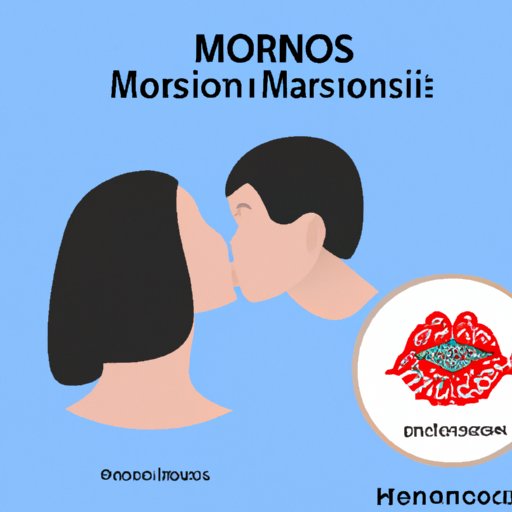
I. Introduction
Mononucleosis, commonly known as “mono,” is a common viral infection that affects many people worldwide. It is most commonly diagnosed in teenagers and young adults. In this article, we will discuss the symptoms of mono, its causes and risk factors, diagnosis, treatment options, complications, prevention, and when to seek medical attention. By the end of this article, you will be able to identify whether you or someone you know has mono and know what steps to take for recovery.
II. Symptoms of Mono
Mono is caused by the Epstein-Barr virus (EBV). It is spread through contact with the saliva of an infected person, which is why it’s often referred to as the “kissing disease.” Symptoms of mono can range from mild to severe and may include:
- Fatigue
- Sore throat
- Swollen glands
Other symptoms that may occur less frequently include:
- Fever
- Headache
- Body aches
III. Causes and Risk Factors
Mono is caused by the Epstein-Barr virus (EBV), which is a member of the herpesvirus family. The virus remains in the body for life after the initial infection, but most people do not experience any symptoms after the first infection. Factors that lead to the development of mono include:
- Weakened immune system
- Stress
- Lack of sleep
- Poor nutrition
Risk factors for mono include:
- Age (teenagers and young adults are at higher risk)
- Living in close quarters with others (such as dormitories)
Other conditions that can mimic symptoms of mono include:
- Strep throat
- Flu
- Chronic fatigue syndrome
- Lyme disease
IV. Diagnosis
Diagnosing mono can be challenging because its symptoms can mimic those of other illnesses. A healthcare provider will typically take a medical history, perform a physical exam, and order blood tests to confirm the diagnosis. Tests used to diagnose mono include:
- Monospot test: This detects the antibodies to the Epstein-Barr virus in the blood.
- EBV-specific antibody test: This test looks for specific antibodies produced by the immune system to attack the virus.
A positive diagnosis means that the person has been infected by the virus and that their immune system has produced antibodies to fight against it.
V. Treatment Options
There is no specific treatment for mono. The virus must run its course, which can take several weeks or even months. Treatment of mono typically focuses on managing symptoms and supporting the immune system. Common treatments for mono include:
- Rest: This helps the body recover and can prevent complications.
- Hydration: Drink plenty of fluids to prevent dehydration and aid in recovery.
Over-the-counter medication can be used for symptom relief. These may include:
- Pain relievers, such as acetaminophen or ibuprofen, to reduce fever and relieve pain.
- Throat lozenges or sprays to soothe a sore throat.
Lifestyle changes can also aid in recovery. These may include:
- Eating a healthy diet rich in fruits, vegetables, and protein.
- Getting enough sleep
- Reducing stress
VI. Complications
Most people recover from mono without any long-term complications. However, complications can occur in rare cases. These may include:
- Enlarged spleen
- Juvenile rheumatoid arthritis
- Meningitis
- Guillain-Barre Syndrome
Warning signs to look out for if complications arise include:
- Severe abdominal pain
- Difficulty breathing
- Severe headache
- Shortness of breath
If complications occur, it is essential to seek medical attention immediately.
VII. Prevention
While it is not always possible to prevent the spread of mono, there are several tips for reducing the risk of developing mono. Strategies for avoiding infection include:
- Avoid sharing utensils, cups, and other items that come into contact with saliva.
- Avoid kissing someone who has mono or showing symptoms of it.
- Wash hands frequently, especially before eating or touching the face.
- Do not share personal items, such as towels, with others.
VIII. When to Seek Medical Attention
While most cases of mono can be managed at home, certain warning signs indicate the need for immediate medical attention. These may include:
- Difficulty breathing or swallowing
- Severe headache and neck stiffness
- Sharp abdominal pain
- Jaundice (yellow discoloration of the eyes and skin)
If symptoms worsen or if someone is experiencing severe pain or difficulty breathing, it is essential to seek medical attention immediately.
IX. Conclusion
In conclusion, mono is a common viral infection that affects many people worldwide, especially teenagers and young adults. Symptoms of mono include fatigue, sore throat, and swollen glands. Diagnosis of mono can be challenging, and treatment typically focuses on managing symptoms. Lifestyle changes, such as getting enough rest and hydration, can aid in recovery. While most people recover from mono without complications, it is essential to seek medical attention if warning signs arise. By following prevention strategies and seeking medical attention when necessary, you can help prevent the spread of mono and ensure a speedy recovery.




